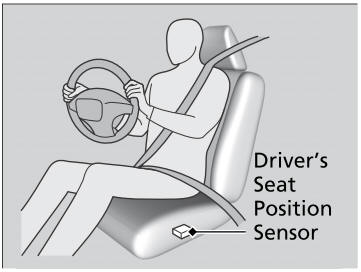Honda CR-V: Lane Keeping Assist System (LKAS) / The LKAS Conditions and Limitations
Honda CR-V 2017-2025 Owner's Manual / Driving / When Driving / Lane Keeping Assist System (LKAS) / The LKAS Conditions and Limitations
The system may not detect lane markings and therefore may not keep the vehicle in the middle of a lane under certain conditions, including the following:
Environmental conditions
- Driving in bad weather (rain, fog, snow, etc.).
- Sudden changes between light and dark, such as an entrance or exit of a tunnel.
- There is little contrast between lane lines and the roadway surface.
- Driving into low sunlight (e.g., at dawn or dusk).
- Strong light is reflected onto the roadway.
- Driving in the shadows of trees, buildings, etc.
- Shadows of adjacent objects are parallel to lane markings.
- Roadway objects or structures are misinterpreted as lane markings.
- Reflections on the interior of the front windshield.
Roadway conditions
- Driving on a snowy or wet roadway (obscured lane marking, vehicle tracks, reflected lights, road spray, high contrast).
- Driving on a road with temporary lane markings.
- Faint, multiple, or varied lane markings are visible on the roadway due to road repairs or old lane markings.
- The roadway has merging, split, or crossing lines (e.g., such as at an intersection or crosswalk).
- The lane markings are extremely narrow, wide, or changing.
- The vehicle in front of you is driving near the lane lines.
- The road is hilly or the vehicle is approaching the crest of a hill.
- Driving on rough or unpaved roads, or over bumpy surfaces.
- When objects on the road (curb, guard rail, pylons, etc.) are recognized as white lines (or yellow lines).
- When driving on roads with double lines.
Vehicle conditions
- Headlight lenses are dirty or the headlights are not properly adjusted.
- The outside of the windshield is streaked or blocked by dirt, mud, leaves, wet snow, etc.
- The inside of the windshield is fogged.
- The camera temperature gets too high.
- An abnormal tire or wheel condition (wrong sized, varied size or construction, improperly inflated, compact spare tire, etc.).
- The vehicle is tilted due to a heavy load or suspension modifications.
- The vehicle is towing a trailer.
 To cancel
To cancel
To cancel the LKAS:
Press the MAIN or LKAS button.
The LKAS is turned off every time you stop the
engine, even if you turned it on the last time
you drove the vehicle...
 Vehicle Stability Assist™ (VSA®), aka Electronic Stability Control (ESC),
System
Vehicle Stability Assist™ (VSA®), aka Electronic Stability Control (ESC),
System
VSA® helps to stabilize the vehicle during cornering if the vehicle turns
more or less
than what was intended. It also assists in maintaining traction on slippery
surfaces...
Other information:
Honda CR-V 2017-2025 Owner's Manual: Audio System Theft Protection
The audio system is disabled when it is disconnected from the power source, such as when the battery is disconnected or goes dead. In certain conditions, the system may display a code entry screen. If this occurs, reactivate the audio system. Reactivating the audio system Turn the ignition switch to ON *1 ...
Honda CR-V 2017-2025 Owner's Manual: Heated Steering Wheel *
*: Canadian models only, if equipped The power mode must be in ON to use the heated steering wheel. Press the button on the right side of the steering wheel. When a comfortable temperature is reached, press the button again to turn it off. The heated steering wheel is turned off every time you start the engine, even if you turned it on the last time you drove the vehicle...
Categories
- Manuals Home
- Honda CR-V Owners Manual
- Honda CR-V Service Manual
- USB Port(s)
- TPMS Calibration
- Wallpaper Setup
- New on site
- Most important about car
Advanced Airbags
The airbags have advanced features to help reduce the likelihood of airbag related injuries to smaller occupants.
The driver's advanced airbag system includes a seat position sensor.

Copyright © 2025 www.hocrv.com
